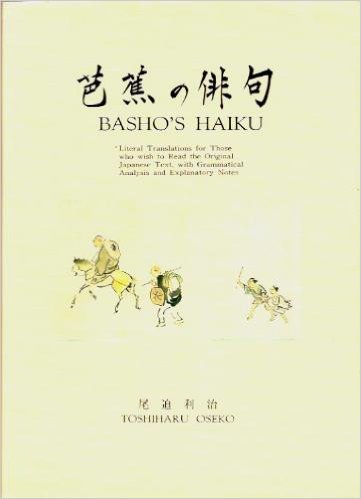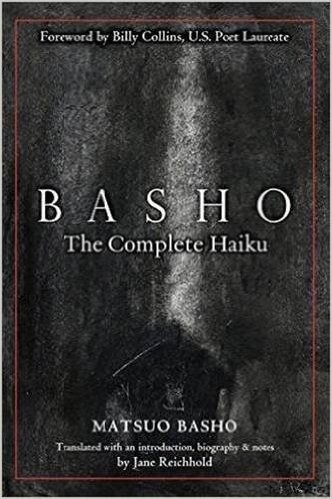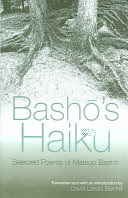Haiku, haibun, and renga of Bashō
Matsuo Bashō
 Writings.
Writings.
 Haiku.
Haiku.
 Haibun.
Haibun.
 Renga.
Renga.
 Time Line.
Time Line.
Other pages on Matsuo Bashō
 Oseko's annotated translations.
Oseko's annotated translations.
 Comparison of Oseko and Reichhold translations.
Comparison of Oseko and Reichhold translations.
 Examples of Oseko and Reichhold and Barnhill translations.
Examples of Oseko and Reichhold and Barnhill translations.
 Comparison of other translations from Bashō's haibun.
Comparison of other translations from Bashō's haibun.
Having various translations lets one understand better what was
likely to be the original intention of Bashō.
In particular, I compared
paragraphs and poems of Narrow Road
in many translations. These are listed in reverse-chronological order here:
Early Modern Japanese Literature: An Anthology, 1600-1900:
edited by Introductions and Commentary by Haruo Shirane.
Over a thousand pages of material by 32 translators.
Much of the work (including Shirane's own translation of Narrow Road to the Deep North
pp 209-232)
previously appeared in the literature.
Rediscovering Basho: A 300th Anniversary Celebration:
edited by Stephen Henry Gill and C. Andrew Gerstle.
13 essays in appreciation of the poetry legacy of Japanese poet
Bashō (1644-1694),
particularly in his
haiku.
The collection includes Nobuyuki Yuasa's "Laughter in Japanese Haiku",
Tsunehiko Hoshino's " Basho and I: The Significance of Basho
300 Years after his Death",
and Makoto Ooka's "Poetry for the Computer Age: Antidote for Anomie".
Contains a delightful group travel haibun "In the Autumn Wind: Offa's Dyke: A Haibun Travel Journal",
edited by Stephen Henry Gill and Fred Schofield, with haiku by
poets that participated in the five-day mountain tromp on uneven ground
through rain, descended cloud, and wind.
Gill (p. 11 in Footnote 13 to his article "Shepherd's Purse") mentions the original manuscript:
| [I]n November 1996, it was 'officially announced' that Basho's original
'Narrow Road' manuscript had indeed been found — in an antique bookshop in Osaka,
the city where he had died.
It had been lost for 250 years!
The manuscript clearly shows Basho's careful redrafting and editing for overall compositional
balance, always apparently conscious of his poetic travelogue being in effect a 'linked verse'
of prose and haiku, which, like a piece of music, needs to lead forward while echoing
developments that have already been played.
|
[The editors' convention is "Basho" rather than "Bashō".]
Haibun
Barnhill, David Landis (translation and introduction):
Bashō's Journey: The Literary Prose of Matsuo Bashō
Excellent translations and commentary. Highly recommended.
Highlights:
- Selected chronology of the life of Matsuo Bashō.
- Four maps.
- 12 pages devoted to an Introduction to Bashō's Journey.
- Journey of Bleached Bones in a Field.
- Kashima Journal.
- Knapsack Notebook.
- Sarashina Journal.
- The Narrow Road to the Deep North.
- Saga Diary.
- Selected Haibun.
- 36 pages for Notes.
- 4 pages for Glossary.
See also:
Basho's Haiku: Selected Poems of Matsuo Basho (2004),
translated and with an introduction by David Landis Barnhill. 724 poems.
The Narrow Road Haibun
Facts on the The Narrow Road journey:
- 1689 (5 years before his death).
- 150 days
- traveled on foot (with occasional assistance by horse)
- with one companion for much of the journey
- distance 600 ri (approximately 2450 kilometers)
Hamill, Sam. Translator:
Narrow Road to the Interior
Hamill:
- Prefaces the translation with an introduction emphasizing the spiritual nature
of the described journey, while describing "a much more Spartan existence"
than we believe Bashō
experienced: historically, he and his companion Sora were "welcomed by
wealthy merchant-class patrons" "along most of the journey".
- Condenses the prose by about 30%.
- Adds words and even phrases to the poems.
- Includes charming brush-painting illustrations by Stephen Addiss.
1996: Keene, Donald (translation and introduction):
The Narrow Road to Oku, illustrated by Miyata Masayuki
- Parallel text in Japanese and English; also kanji of the haiku.
Very interesting and helpful.
- Illustrated by Miyata Masayuki, master of kiri-e
(collage, literally 'cut pictures'), 1995 official U.N. artist
(the first Japanese to be appointed). His artist's note includes:
|
Producing a picture to represent each haiku in
The Narrow Road to Oku
was a matter of having to select one tiny 'point' -- a mere 'dot.'
One misjudgment in my reading and the picture would lose touch with the spirit of
Bashō's work and end up simply as an illustration that
happened to be accompanied by a haiku.
|
His illustration are strong yet delicate,
such as his stunning image with
six layers of islands in a gleaming ocean for the Matsushima haiku [p. 81]
and his remarkably energized
Mogami River, with waterfalls, valleys, and a river-tossed boat [p. 101].
One of the most brilliant images is his snowy moonlit Moon Mountain [p. 109].
- Keene's translation is pleasing in many ways, including:
- The full prose text (instead of the heavily cut version of
Hamill).
- Haiku that adhere more closely to the original Japanese (instead of
having inserted words as by
Hamill).
- 56 annotations (occupying 8 pages)
that provide rich cultural background
(of history, customs, words, and so on) to enliven the reading.
- Conversion (or parallel presentation) of many Japanese place names
into English.
Thus, instead of Muro-no-Yashima
[Hamill],
Keene gives us the Doorless Shrine of the Cauldron.
Instead of Kurobane, Keene writes Black Wing.
And so on.
Keene thereby brings the countryside's appearance more alive.
- Approximately 5-7-5 pattern (sometimes with slightly fewer syllables
particularly in the first and second lines);
so the poems echo that aspect of the originals.
1966: Yuasa, Nobuyuki (translation and introduction):
The Narrow Road to the Deep North and Other Travel Sketches, illustrated by Yosa Buson
- 41-page introduction.
- Translation of 5 haibun by Bashō:
- The Records of a Weather-Exposed Skeleton (14 pp.)
- A Visit to the Kashima Shrine (6 pp.)
- The Records of a Travel-worn Satchel (20 pp.)
- A Visit to Sarashima Village (5 pp.)
- The Narrow Road to the Deep North (47 pp.)
- 3 maps of Bashō's routes in Japan.
- 19 pages of notes at the end.
- Illustrated by Yosa Buson.
- The haiku are translated in four lines (instead of the usual three),
even though Yuasa translates tanka as the usual five lines (pp. 9-11 for example).
1968: Cid Corman and Kamaike Susumu (translation and introduction):
The Narrow Road to the Deep North and Other Travel Sketches
Disappointing in both the translations and illustrations
The sole redeeming feature is that it includes the Japanese in kanji and kana, as does
Keene.
Ueda, Makoto: The Master Haiku Poet Matsuo Basho:
across the plain
Consider first The Narrow Road's
poem written in response to a request
(from the man leading Bashō's horse)
to receive a poem-card.
The sound of the poem in Japanese is approximated by this Romaji
[Keene, p. 43]:
no wo yoko ni
uma hikimuke yo
hototogisu
|
Keene's version (also p. 43):
Lead the horse sideways
Across the meadows -- I hear
A nightingale.
|
The word "sideways" seems awkward in his translation;
I had to read other versions before Keene's version made sense to me.
Hamill's version [p. 18]
seems to claim a response of the horse to a bird cry
(an alarm rather than a "song"?)
and from a different bird, one that in the west is a terrorist rather than a chorister:
The horse lifts his head:
from across deep fields
the cuckoo's cry
|
Cid Corman's version doesn't bother to translate the bird:
across the fields
head the horse
hototogisu
|
But it was not till I turned to
Barnhill's version
that I found a version that made sense ... and that I preferred as a poem:
across the plain,
turn my horse over there!
cuckoo
|
Later I found
Yuasa's earlier version [p. 105]
in his four-line format with a closing period.
It also uses "turn" for the verb,
which works well:
Turn the head of your horse
Sideways across the field,
To let me hear
The cry of a cuckoo.
|
My preference is for Barnhill's version,
with its clarity and concision.
Now consider
The Narrow Road's
poem written at Palace-on-the-Heights.
The sound of the poem in Japanese is approximated by this Romaji
(Keene, p. 87):
natsukusa ya
tsuwamono domo ga
yume no ato
|
and his translation:
The summer grasses --
Of brave soldiers' dreams
The aftermath.
|
Jane Hirshfield
offers a similar by slightly variant version on p.51 of her
Ten Windows: How Great Poems Transform the World (2015):
natsu gusa ya tsuwa mono domo ga yume no ato
|
and her translation:
summer grasses:
what is left
of warriors' dreams
|
Hamill's version (p. 51):
Summer grasses:
all that remains of great soldiers'
imperial dreams
|
Shirane's version (p. 221):
Summer grasses—
the traces of dreams
of ancient warriors
|
Shirane's version is better than most. Even more helpful,
his book includes a 32-line footnote on the sounds
and the layered meanings of words in the original.
Cid Corman's version is too concise:
summer grass
warriors
dreams' ruin
|
Barnhill's version (p.62) is again my preference for its clarity and concision:
summer grass—
all that remains
of warriors' dreams
|
Yuasa's version (p. 118)
in his four-line format:
A thicket of summer grass
Is all that remains
Of the dreams and ambitions
Of ancient warriors.
|
Reichhold's versions (p.137, her 528):
summer grass
the only remains of soldiers'
dreams
|
Oseko's versions (his 150):
Only summer grass grows
Where ancient warriors
Used to dream!
|
Now consider The Narrow Road's
poem written after turning down a request to walk with them from two young prostitutes.
The sound of the poem in Japanese is approximated by this Romaji
[Keene, p. 131]
(almost identical in
Ueda, p. 144):
hitotsu ya ni
yū'jo mo netari
hagi to tsuki
|
Keene's version (also p. 131):
Under the same roof
Prostitutes were sleeping —
The moon and clover.
|
This has such resonance: the moon of enlightenment with traveling poets;
the bright clover with the young women.
Hamill's version [p. 75]
implies a closer juxtaposition that turns the haiku into a senryu:
Under one roof, prostitute and priest,
we all sleep together:
moon in a field of clover
|
I understand that there is no explicit Japanese word for "priest"
in the Japanese haiku.
So, Hamill is adding into the poem something to indicate that the
traveling poets presented themselves as priests.
Shirane's version (p. 230):
Under the same roof
women of pleasure also sleep—
bush clover and moon
|
Barnhill's version (p.70) is again my preference:
in the same house
prostitutes, too, slept:
bush clover and moon
|
Cid Corman's version (whose notes claim that 'play-girls' is a
more exact translation than 'prostitutes')
in the one house
play-girls also slept
hagi and moonlight
|
Ueda's version [p. 141], though, is the most gentle, with its
"too" and "are asleep":
Under the same roof
Courtesans, too, are asleep--
Bush clover and the moon.
|
Yuasa's version [p. 132]
in his four-line format:
Under the same roof
We all slept together,
Concubines and I —
Bush-clovers and the moon.
|
Reichhold's version (p.143, her 564):
in one house
prostitutes lie down to sleep
bush clover and the moon
|
Oseko's version (his 170):
Under the same roof,
Prostitutes are also sleeping.
Bush clover and the moon.
|
Here, I also like Ueda's version
and
Oseko's version.
Lastly consider The Narrow Road's
poem written after visiting the Tada Shrine (in Komatsu) with its famous warrior's helmet.
The sound of the poem in Japanese is approximated by this Romaji
[Keene, p. 143]
(identical in
Ueda, p. 141):
muzan ya na
kabuto no shita no
kirigirisu
|
Keene's version (also p. 143):
Alas for mortality!
Underneath the helmet
A grasshopper.
|
Hamill's version [p. 81]:
Ungraciously, under
a great soldier's empty helmet,
a cricket sings
|
Hamill's version
uses 'Ungraciously' for muzan (which others understand as 'cruel' or 'ruthless'
or 'pitiful') and inserts 'sings', which is not in the original.
Also missing from the original is another Hamill insertion:
'great soldier's empty' to describe helmet, kabuto.
That word comes from Japanese antiquity, and gives the image of a fallen soldier.
Hamill's insertion of those words in the haiku is not only that he is inserting words;
he is also duplicating the sense of the prose — something that is usually to be avoided in
Haibun:
Shirane's version (p. 230):
"How pitiful!"
beneath the warrior's helmet
cries of a cricket
|
Shirane's book includes a 24-line footnote on the historical resonances in this poem.
Barnhill's version (p.72):
so pitiful—
under the helmet,
a cricket
|
Cid Corman's version (again compact, perhaps excessively)
cruel!
under the helmet
cricket
|
Ueda's version [p. 141]:
How pitiful!
Underneath the helmet
A cricket chirping.
|
Yuasa's version [p. 134]
in his four-line format:
I am awe-struck
To hear a cricket singing
Underneath the dark cavity
Of an old helmet.
|
Reichhold's version (p.144, her 571):
how pitiful
under the armored helmet
a cricket
|
Oseko's version (his 176):
How pitiful it is,
To hear a cricket chirping
Underneath the helmet!
|
- 1600
- Start of Edo period.
- 1644
- Birth of
Matsuo Bashō in the city of Ueno.
He would become the first poet to compose independent hokku
(or in Shiki's term, haiku).
- 1653
- Bashō became employed as a page and study-mate to Yoshitada, the young heir of the
Tōdō family.
- 1655
- Death of Bashō's father.
- 1666
- Death of Yoshitada (by then using the pen name Sengin).
When Bashō's request to resign was rejected, he ran away to Kyōto,
where he studied while possibly living at the Kinpukuji (a temple).
- 1671
- Bashō returned to his native home, where he remained for some months.
- 1672
- Bashō went to Edo (today's Tōkyō) where he began to be recognized poetically.
- 1675
- Met Sōin from Ōsaka. From him, Bashō learned:
"the special value of the poetry of the humble and unpretentious imagery
of everyday life ...
reflect[ing] the playful tone and ingenious style of Sōin."
(Yuasa's The Narrow Road to the Deep North and Other Travel Sketches, p. 24).
- 1680
- Sanpuu, an admirer of
Matsuo Bashō, built him a hut in a quiet place
in Fukagawa near the River Sumida.
That winter one of his students presented him with a Bashō tree (a species of banana),
shortly after which he used that as the name of his house and as his pen name
(Yuasa's The Narrow Road to the Deep North and Other Travel Sketches, p. 25-26).
- 1682
- Matsuo Bashō's hut was destroyed in a city fire that burned much of Edo.
- 1683
- Death of Bashō's mother.
In winter friends and disciples built a new house for him in Fukagawa.
- 1684
- Bashō's first major journey, leading to his first travel sketch
"The Records of a Weather-Exposed Skeleton" (14 pp. in
Yuasa's The Narrow Road to the Deep North and Other Travel Sketches,
starting on p. 51). He went mainly west from Edo, reaching Kyoto and Nara. His report
of his arduous nine-month foot journey is written as a haibun
but the prose and poetry in this early version are in want of balance.
While he was in Nagoya Fuyu no Hi (A Winter Day), the first Bashō
anthology was published.
- 1686
- Publication of two Bashō anthologies:
Kawazu Awase (Frog Contest) and
Haru no Hi (A Spring Day).
By this time "crude personification and ingenious self-dramatization have
completely disappeared from his poems"
(Yuasa's The Narrow Road to the Deep North and Other Travel Sketches, p. 34).
- 1687
- Bashō's short trip to the Kashima Shrine led to his short travel sketch
"A Visit to the Kashima Shrine" (6 pp. in
Yuasa's The Narrow Road to the Deep North and Other Travel Sketches,
starting on p. 61).
Bashō's second major journey, taking about eleven months and following a similar
route to that of 1684.
This led to two travel sketches:
At the time he was "coming out of the agonizing years of self-scrutiny, and was busy finding his identity in
nature" (Yuasa, p. 35).
- 1687
- Bashō returned.
- 1689
- Bashō's third major journey, taking thirty months and heading north, crossing to the west coast,
then heading south.
In Spring and Summer, accompanied by his friend Sora,
Matsuo Bashō
walked in Japan's Northern Interior.
During his remaining 5 years,
Matsuo Bashō
polished his travel diary of that journey to make
Oku-no-hosomichi.
- 1694
- Death of Matsuo Bashō.
-
Links and Books.
-
[Thanks for visiting.]
 Highlights of Poetry.
Highlights of Poetry.
 Index of poetry.
Index of poetry.
 How to Write Poetry.
How to Write Poetry.
 Books read.
Books read.
 Yuki Teikei Haiku Society:
Yuki Teikei Haiku Society:
 Join.
Join.
 GEPPO magazine.
GEPPO magazine.
 Annual anthologies.
Annual anthologies.
 2007.
2007.
 2008
(a haibun).
2008
(a haibun).
 2010.
2010.


 Toward an Aesthetic for English-Language Haiku by Lee Gurga.
Toward an Aesthetic for English-Language Haiku by Lee Gurga.
 2004 Pescadero Haiku Weekend Workshop (including exercises) with Christopher Herold.
2004 Pescadero Haiku Weekend Workshop (including exercises) with Christopher Herold.
 Haibun.
Haibun.
 Haiku.
Haiku.
 Hay(na)ku.
Hay(na)ku.
 Rengay.
Rengay.
 Renku.
Renku.
 Tanka.
Tanka.
 Ballade.
Ballade.
 Concrete.
Concrete.
 Ghazal.
Ghazal.
 Lai.
Lai.
 Pantoum.
Pantoum.
 Prose poem.
Prose poem.
 Rondeau.
Rondeau.
 Rubáiyát.
Rubáiyát.
 Sestina.
Sestina.
 Skaldic verse.
Skaldic verse.
 Sonnet.
Sonnet.
 Terza rima.
Terza rima.
 Triolet.
Triolet.
 Tritina.
Tritina.
 Villanelle.
Villanelle.
 Bashō.
Bashō.
 Buson.
Buson.
 Hosai Ozaki.
Hosai Ozaki.
 Ki no Tsurayuki.
Ki no Tsurayuki.
 Shiki.
Shiki.


